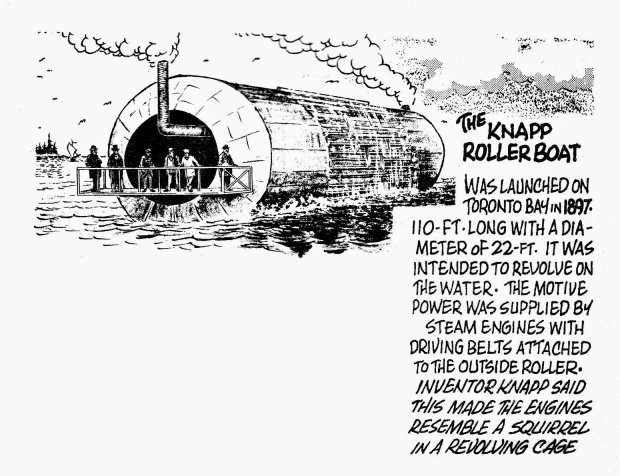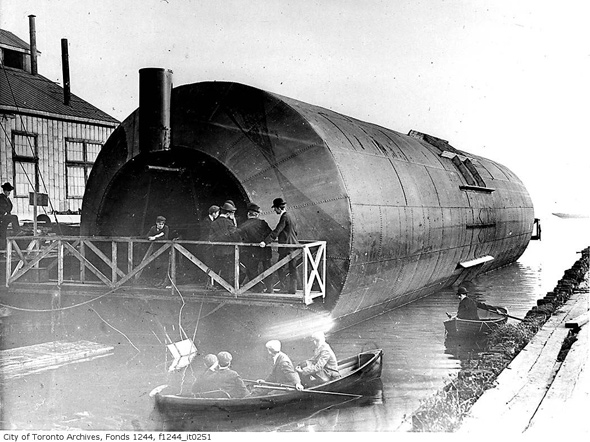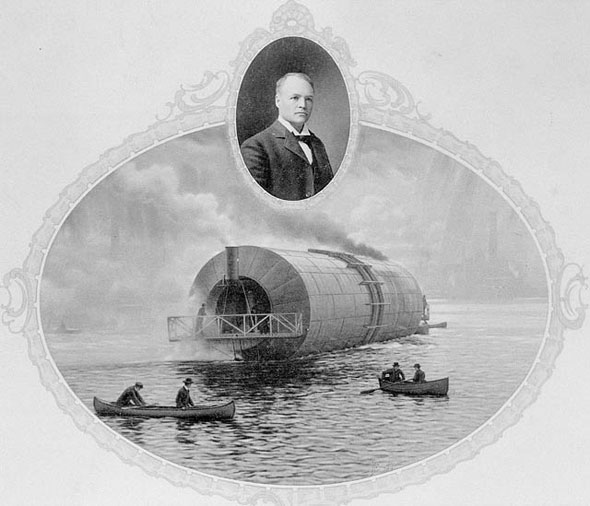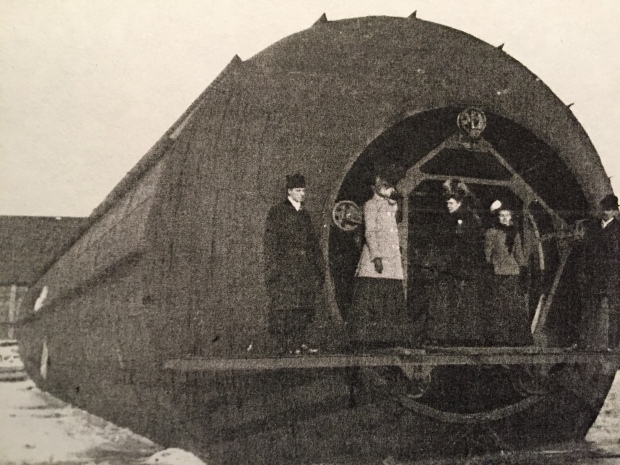“Meetcha at the fountain.”
That was a phrase most teenagers of the 1980s were saying when they wanted to meet up with friends at the local mall. Before Snapchat or texting, us 80s kids had to phone each other from our parents kitchen phone to make plans to hangout IRL where all the cool kids hung out: The Mall.

This newspaper clipping shows the exact fountain I spent many of my teenage days sitting around at Catarqui Town Centre in Kingston, ON…..there was an amazing arcade just to the right of this photo…note the MMMMMMMuffins in the background. (Photo: Whig-Standard)
The Shopping Malls of the 1980s were extravagant retail meccas, a place for us awkward kids to spend our allowance on a bag of Kernels, some posters from Discus, video games from CompuCentre, and the idyllic spot where our parents did their year round shopping under the dappled rays of a skylit roof.

There was nothing like the mall of the 1980s. Note the ever present water fountain, tropical plants, and, smoking. (photo: CBS News)
Appointed with soothing beige tile work, usually complimented with a mix of wood and teal/dusty rose trim, there was nothing quite like the malls of the 80s. In addition to their era-specific decor splendor, they almost always had another common feature: A massive water fountain.
Spraying a geyser of chlorinated water into the dry mall air, its burbling sounds and circular construction was always a welcome and soothing sight to behold, a place to relax , congregate and meet up with your school pals for an afternoon of hanging out at the mall. Yet this once core landmark has now vanished from most shopping malls, their demise brought on by the downward spiral of the mall retail model. Cutting corners and adapting to increase their profits, the mighty water fountains of malls are deemed too expensive to maintain, and likely were a liability (yes we all know someone who jumped or fell in one) or maybe the coins we all tossed in for our deepest wishes were too much to bear for the mall management to wrap and donate to charity.

The now dry water fountain of the Glebe’s Fifth Avenue Court. (Image: GoogleMaps)
Before they all disappear from existence, lets tease our hair, pull up our tube socks and take a take a step back in time for a look at Ottawa’s FOUNTAINS OF OUR YOUTH.
MALL MANIA
The shopping mall was a post-war retail concept primarily based on the transition of residential areas moving into a suburban mode of living. Servicing these new suburbs with shopping “centres” involved an enclosed space with stores indoors, away from downtown, and accessible only by car. Ottawa has its share of early 1950s malls, but the focus of this piece are malls that featured opulent water fountains.

An American shopping centre developer by the name of Taubman revolutionized shopping malls by introducing tiled floors instead of carpet, indoor fountains, and two levels, allowing a shopper to make a circuit of all the stores. Daylight was filtered through glass skylights making it seem like the afternoon was lasting longer, which encouraged shoppers to linger the whole day.

The massive green trees that used to be at Rideau Centre mall in 1983 (photo: CBC archives)

The once prevalent greenery of plants at shopping malls is now gone. Remember these at the Rideau Centre? (photo: CBC archives)
The water fountain and accompanying greenery of a mall was to create an “oasis” for the shopper, a place to relax and enjoy the shopping experience, like going on a vacation. Under the calming sounds of burbling water amidst lush tropical plants, you could buy your slacks and some MMMMMMuffins to snack on. The fountain was where parents would tell kids to meet if they got separated, a rendezvous place, and a spot for kids to toss coins into the depths of the crystal clear waters in hopes that a special wish came true.

The epic water fountain that was once at Bayshore Shopping Centre. Like the parent pictured, many a son/daughter were propped up on its ledge to make a wish and toss a coin into its burbling waters. (photo: Lost Ottawa)
One of the most notable mall fountains in Ottawa was the one at Bayshore Shopping Centre. Bayshore opened in 1973, and featured an epic central fountain with a commissioned sculpture of “very thin people” dancing in its spray. Most of Ottawa that shopped there between 1973 and the 80s remember this very memorable fountain, until it mysteriously disappeared during renovations.

PLANTS! LOTS OF THEM! Another view of Bayshore Shopping Centre’s landmark water fountain. A virtual jungle oasis. (photo: LostOttawa)

That exact same spot today. No plants, no fountain. Sterile.
A common misconception about that fountain sculpture is that it was moved to Sparks Street. A similar looking sculpture does exist on Sparks Street, but that was one commissioned by ER Fisher when his men’s store was down there. That sculpture is called “Joy” by the late Bruce Garner, with the elusive Bayshore fountain sculpture made by someone else.
Through some investigative sleuthing and a source that will remain anonymous (thank-you), I believe I have been able to locate the Bayshore Fountain, which still exists in Ottawa. The iconic bronze sculpture was done by a German artist, Almuth Lütkenhaus.

The Bayshore water fountain sculptor revealed…Almuth Lutkenhaus.

Lutkenhaus at work on one of her sculptures. She died in 1996.
Studying her craft in Germany until she moved to Canada in 1966, Lütkenhaus was commissioned to do the 15 foot high bronze sculpture for the newly constructed Bayshore Shopping Centre in 1972, as discovered in an old artist catalogue that mentioned the sculpture.
Prominently installed amidst a geyser of water in the centre of Bayshore shopping mall, when it first opened, Lütkenhaus’ sculpture was later removed sometime later when the mall underwent renovations, disappearing from public view.
Enjoyed by thousands of Ottawa shoppers and kids who were propped up on its ledge, how could such a prominent and beloved sculpture suddenly just disappear? After contacting some folks who might be in the know, I was told that it was sold off to a “private collector” for their private property here in Ottawa. Who bought such a well-known public art piece? It must be someone of stature, someone who in the 80s-90s was wealthy enough and had the grounds big enough to accommodate the large art piece. Who fits this description? Let’s look at a few suspects….Bill Teron was a wealthy developer of the time who built his massive estate out in Kanata, but a Google search showed no connection. Next, COREL founder Michael Cowpland.
Cowpland launched Cowpland Research Laboratory, COREL in Ottawa in 1985, amassing a fortune and building a metallic encrusted estate in Rockcliffe Park in the 1990s, which in 2008, ranked as Ottawa’s third most valuable private property with an assessed worth of CAN $12.5 million.

Marlen Cowpland, poolside. (photo: Ottawa Sun)
A quick Bing Maps aerial 3D view shows the estate has a swimming pool with… wait a second, a CIRCULAR FOUNTAIN AND SCULPTURE OF FIGURES. A zoom-in reveals what looks to be a match to our beloved Bayshore Fountain sculpture by Lütkenhaus.

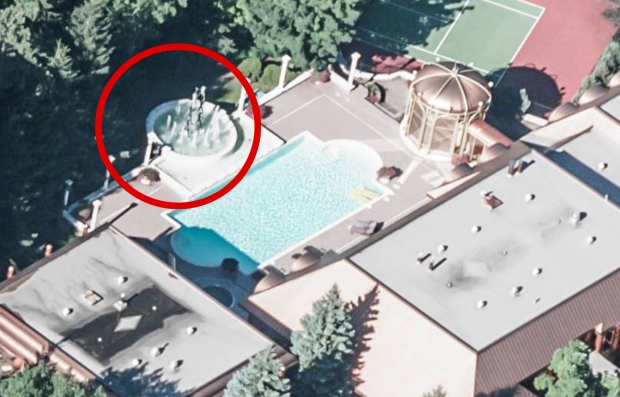

I can not confirm this 100% without access from the Cowplands (I think they still own it?) into their estate to see it in person, but it seems to me that the Lost Fountain Of Our Youth lies poolside in their backyard.
FADING FOUNTAINS
In the mid-1990s, shopping malls were still being built at a rate of 140 a year, but in 2001 malls began to decline in popularity and were called “greyfield” and “dead mall” estates. With the advent of online shopping through web retailers like Amazon, shopping malls began their death spiral, with some management corporations adjusting their retail mall model to the open air “Big Box” mall approach, with the enclosed malls now defunct. Cheaper to maintain without the indoor common areas, these big box malls did away with frivolous fountains and plants in favour of asphalt parking lots.

The once mighty water fountain at Place D’Orleans Mall, removed and now leased out to auto dealerships to display their vehicles.
Place D’Orleans Mall expanded to its current size in 1990 and had a re-opening event, but it was to be one of the last enclosed malls built in Canada. It’s massive fountain, once an illuminated Vegas-style light show, has since been removed, its area used to display paying vendors wares.
Hazeldean Mall which opened in October 30, 1979, is the last of Ottawa’s great shopping malls to still operate a water fountain. A trickling stepped fountain that once ran from one end of the mall to the other has now been reduced in size, but still functions.

Hazeldean Mall is Ottawa’s last shopping mall to maintain a water fountain. (photo: GoogleStreetview)
Along with the water features, the tropical plants that used to provide a foliaged refuge for shoppers during the bitter winter months have also been removed from most shopping centres, replaced with a clean, sterile aesthetic that resembles Apple’s minimalist environment. . Tall trees and tropical plants were all axed from the malls as their “cost of upkeep” was deemed too expensive in a market that is trying to cut cost any chance it gets. The plants, the fountains, and even the Christmas decor have all been trimmed down along with operating budgets for malls in an effort to compete in what is now a harsh retail environment.

St. Laurent Mall, centre court, no fountain.
The once bustling meccas of our youth, the prime Saturday hangout where we’d hit the Orange Julius, Discus, Zellers, and the arcade, are now but distant memories for us Gen Xers. We are a generation that was raised by retail, television, video games and celebrity fashion trends…wait, maybe much hasn’t changed, but I still miss those soothing mall fountains. If I had known, I would have tossed a dime into their bubbling waters, wishing they would never disappear.
Andrew King, January 2019
SOURCES
Wikipedia
Google Maps
Bing Maps
Lost Ottawa
CBS News
CBC Archives







